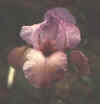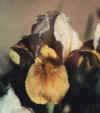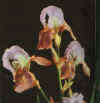Cultivars - A
Cultivars - B
Cultivars - C
Cultivars - D
Cultivars - E
Cultivars - F
Cultivars - G
Cultivars - H
Cultivars - I
Cultivars - J
Cultivars - K
Cultivars - L
Cultivars - M
Cultivars - N
Cultivars - O
Cultivars - P
Cultivars - QR
Cultivars - S
Cultivars - T
Cultivars - UV
Cultivars - W
Cultivars - XYZ
| |
|
BALLALAIKA MUSIC (Mathes, 1992) RC Werckmeister's Beauty X Dunshanbe. Plum ground with violet flush along the midrib of the standards and in the center of the falls. Intense violet in signal area. Breeds like a tetraploid, is compatible with other tetraploid RCs and has produced some really outstanding ¾-bred seedlings for me when I've crossed it with various ½-breds. I recommend it highly to anyone who is interested in working with the tetraploid arils or experimenting with producing ¾-breds. |
|
 BANGLEDESH (Peterson, 1972) OGB Esther, the Queen X Tuesday Song. Standards are a deep blue-violet, veined
even deeper; falls are a darker blackish blue with medium pinkish overcast. Deep brown beard, as dark as those other hybridizers have described as "black".
Of course, grown in full New Mexico sun it tends to be somewhat lighter. Definitely worth using
whether you're seeking a closer approach to black or working with the pinkish pastels as it's given me excellent seedlings of both types. BANGLEDESH (Peterson, 1972) OGB Esther, the Queen X Tuesday Song. Standards are a deep blue-violet, veined
even deeper; falls are a darker blackish blue with medium pinkish overcast. Deep brown beard, as dark as those other hybridizers have described as "black".
Of course, grown in full New Mexico sun it tends to be somewhat lighter. Definitely worth using
whether you're seeking a closer approach to black or working with the pinkish pastels as it's given me excellent seedlings of both types.
|
|
BARBARELLA (Mathes, 1991) OGB A fully fertile, true amphi-diploid from tetraploid aril X I. pumila breeding. Smooth gold standards are flushed darker at midribs. Smooth gold falls have a large signal spot and veining of dark mahogany. Recommended for anyone wanting to develop a line of fertile
arilbredmedians. |
|
 BAYBERRY BABY (McAllister, 1992) OGB Gene's Little
Secret X Rose of Sharon. Light yellow standards faintly tinged green. Yellow-green falls, washed lightly with brown. Limited
fertility. Has produced offspring when crossed with some of its half-sibs, but so far none have proved worthy of introduction. Many years ago, I fell in love with the color of Bayberry Candle (a DeForest TB introduced back in 1969). This is the closest I've come to that special shade, so it practically named itself. Because it's an arilbredmedian, and I have a weakness for alliterative names, "Baby" immediately came to mind. BAYBERRY BABY (McAllister, 1992) OGB Gene's Little
Secret X Rose of Sharon. Light yellow standards faintly tinged green. Yellow-green falls, washed lightly with brown. Limited
fertility. Has produced offspring when crossed with some of its half-sibs, but so far none have proved worthy of introduction. Many years ago, I fell in love with the color of Bayberry Candle (a DeForest TB introduced back in 1969). This is the closest I've come to that special shade, so it practically named itself. Because it's an arilbredmedian, and I have a weakness for alliterative names, "Baby" immediately came to mind.
|
|
 BEADWORK (McAllister, 1995) OGB- Anon X
Boaz. White ground, splattered with shades of yellow, rust, brown, and violet. The result is a no-two-flowers-exactly-alike pattern that reminds the onlooker of crystalline
beadwork. This suggestion won the "Name Game" for Jan Timmons in 1995. No interest in parenthood so far, but
it is certainly worth trying with tetraploid arils because this pattern appears to be recessive with respect to aril traits. BEADWORK (McAllister, 1995) OGB- Anon X
Boaz. White ground, splattered with shades of yellow, rust, brown, and violet. The result is a no-two-flowers-exactly-alike pattern that reminds the onlooker of crystalline
beadwork. This suggestion won the "Name Game" for Jan Timmons in 1995. No interest in parenthood so far, but
it is certainly worth trying with tetraploid arils because this pattern appears to be recessive with respect to aril traits.
|
|
 BEDOUIN NIGHTFALL (McKusick, 1981) RH
Vera X Vulcanus. Very dark brown self; no signal; blue beard. I'm not aware of any chromosome count on this, but it's fertile both ways and certainly breeds like a tetraploid. It's not only somewhat compatible with the tetraploid RCs, but it has given me some very nice, sun-resistant deep reddish brown and reddish violet arilbreds
when crossed with halfbreds. Highly recommended for experimenters who are interested in obtaining first-generation halfbreds by crossing arils with
TBs. BEDOUIN NIGHTFALL (McKusick, 1981) RH
Vera X Vulcanus. Very dark brown self; no signal; blue beard. I'm not aware of any chromosome count on this, but it's fertile both ways and certainly breeds like a tetraploid. It's not only somewhat compatible with the tetraploid RCs, but it has given me some very nice, sun-resistant deep reddish brown and reddish violet arilbreds
when crossed with halfbreds. Highly recommended for experimenters who are interested in obtaining first-generation halfbreds by crossing arils with
TBs.
|
|
BIG BLACK BUMBLEBEE (Danielson, 1966) OGB+ Theseus X WO1. Standards pinkish amethyst veined in mulberry, falls similar but darker and bluer. Bronze beard. Marked by a HUGE black spot the size of a Texas bumblebee. Limitedly fertile. |
|
 BIG COUNTRY (McAllister, 1996) OGB Boaz X Jean Ralls. When this outgrew its spot in the seedling bed, it was so strong that it simply lifted the wooden frame out of the ground. Pastel from recessive lines: very pale lobelia blue standards; pale mimosa yellow falls with V-shaped area of fine reddish-brown dotting and veining around gold-and-brown beard. Bright yellow style arms. Fertile both ways. Use for strong plants. Basketball fans will recognize the nickname of Bryant Reeves, Okahoma State University's 7'2", 290 lb. center, a big blond who can go wherever he pleases on the basketball court. This is a big blond flower, with a plant that grows wherever it pleases in the garden. When it outgrew its spot in the seedling bed, it was so
strong that it simply lifted the wooden frame out of the ground. BIG COUNTRY (McAllister, 1996) OGB Boaz X Jean Ralls. When this outgrew its spot in the seedling bed, it was so strong that it simply lifted the wooden frame out of the ground. Pastel from recessive lines: very pale lobelia blue standards; pale mimosa yellow falls with V-shaped area of fine reddish-brown dotting and veining around gold-and-brown beard. Bright yellow style arms. Fertile both ways. Use for strong plants. Basketball fans will recognize the nickname of Bryant Reeves, Okahoma State University's 7'2", 290 lb. center, a big blond who can go wherever he pleases on the basketball court. This is a big blond flower, with a plant that grows wherever it pleases in the garden. When it outgrew its spot in the seedling bed, it was so
strong that it simply lifted the wooden frame out of the ground.
|
|
BIONIC BURST (Danielson, 1977) OGB+/OGB Esther, the Queen X One More Kiss. Standards light red, falls dark red with a large brownish-black beard. One of my favorite breeders. |
|
BLOND BEARDED LADY (Danielson, 1987) OGB+/OGB Imaret X Dee Mouse White standards have a touch of gold along the midrib. Soft cream falls have some rust-brown dotting and veining. The very large, dark brown beard really stands out in this pastel setting. I've used this with several of my marked-in-chocolate lines. |
|
BLUE ARTS (Danielson, 1986) RB+ (Snow Flurry x I. hoogiana) X (Collectors Pride x I. hoogiana). Bright violet-blue self, pronounced sweet fragrance. This hoogiana-bred is one of the best examples I've seen of an arilbred whose flowers approach the look of an aril species. |
|
 BLUSETTE (Seligmann-McAllister, 1992) OGB Bionic Burst X Prince Thou Art. Butterfly blue self with bright orange-yellow beard. Proven fertile halfbred (although I've given most of its seeds away). It's an extremely strong grower that tends to stay green through the summer like the quarterbreds instead of going dormant with the conventional halfbreds, so I've started using it in attempts to pass on that trait. Its soft color is so rare in arilbreds that it seemed
"Blue" must be used in the name, but there are so many "blue-something-or-other" varieties already out there that this proved to be almost impossible. Its form is more flaring than typical of halfbreds, so somehow the word-association process led to "Blue Musette", which I quickly condensed to
"Blusette". BLUSETTE (Seligmann-McAllister, 1992) OGB Bionic Burst X Prince Thou Art. Butterfly blue self with bright orange-yellow beard. Proven fertile halfbred (although I've given most of its seeds away). It's an extremely strong grower that tends to stay green through the summer like the quarterbreds instead of going dormant with the conventional halfbreds, so I've started using it in attempts to pass on that trait. Its soft color is so rare in arilbreds that it seemed
"Blue" must be used in the name, but there are so many "blue-something-or-other" varieties already out there that this proved to be almost impossible. Its form is more flaring than typical of halfbreds, so somehow the word-association process led to "Blue Musette", which I quickly condensed to
"Blusette".
|
|
 BOAZ (Hunt, 1980) OGB ((Kalifa Baltis x Kalifa Gulnare) x Esther the Queen) X Tuesday Song. Creamy white ground dotted and veined mulberry. Violet-maroon beard. This is an excellent parent, especially if you like surprises in the seedling patch. Crossed with Asha Michelle, it produced some excellent
pseudo-plicatas. Crossed with Anon, it gave not only the pseudo-plicatas but also a striking new pattern with aril-like dotting and veining overlaid on a yellow variegated ground that resulted in an interesting mix of ivory, yellow, violet, and brown. I'm still using this heavily myself. A fully fertile halfbred that I recommend highly, even for beginners. Gene preferred Biblical names for his iris, instead of the Arabic names that many used at the time he started introducing his arilbreds. Boaz was a very unusual man: both wealthy and virtuous. (See the second through fourth chapters of Ruth for the whole story.) Its wealth is in its offspring, its virtue takes many forms. BOAZ (Hunt, 1980) OGB ((Kalifa Baltis x Kalifa Gulnare) x Esther the Queen) X Tuesday Song. Creamy white ground dotted and veined mulberry. Violet-maroon beard. This is an excellent parent, especially if you like surprises in the seedling patch. Crossed with Asha Michelle, it produced some excellent
pseudo-plicatas. Crossed with Anon, it gave not only the pseudo-plicatas but also a striking new pattern with aril-like dotting and veining overlaid on a yellow variegated ground that resulted in an interesting mix of ivory, yellow, violet, and brown. I'm still using this heavily myself. A fully fertile halfbred that I recommend highly, even for beginners. Gene preferred Biblical names for his iris, instead of the Arabic names that many used at the time he started introducing his arilbreds. Boaz was a very unusual man: both wealthy and virtuous. (See the second through fourth chapters of Ruth for the whole story.) Its wealth is in its offspring, its virtue takes many forms. |
|
 BOLD AND BEAUTIFUL (McAllister, 1990) OGB+/OGB
CGW-type arilbred seedling of unknown parentage X Tribe of Judah. Lilac standards splashed darker violet. Golden falls splashed orange and brown. Terracotta spot. A proven fertile
halfbred, but I've used it very little because I prefer parents with better defined pedigrees – but it did give me one exceptionally nice quarterbred when crossed onto Apricot Blaze and a striking lavender over violet with globular form when crossed with Whirlwind Romance.The flambouyant colors (lilac standards splashed darker violet, golden falls splashed orange and brown, and a terracotta spot) sound almost garish – but a clump of this always drew the attention of garden visitors. The TV program, "The Bold and the Beautiful", premiered while I was trying to find a name for this one. The title had to shortened to meet the three word limit, of course, but it did provide the needed inspiration. An
OGB+ in the old quantum system under which it was registered, it qualifies as an OGB today. BOLD AND BEAUTIFUL (McAllister, 1990) OGB+/OGB
CGW-type arilbred seedling of unknown parentage X Tribe of Judah. Lilac standards splashed darker violet. Golden falls splashed orange and brown. Terracotta spot. A proven fertile
halfbred, but I've used it very little because I prefer parents with better defined pedigrees – but it did give me one exceptionally nice quarterbred when crossed onto Apricot Blaze and a striking lavender over violet with globular form when crossed with Whirlwind Romance.The flambouyant colors (lilac standards splashed darker violet, golden falls splashed orange and brown, and a terracotta spot) sound almost garish – but a clump of this always drew the attention of garden visitors. The TV program, "The Bold and the Beautiful", premiered while I was trying to find a name for this one. The title had to shortened to meet the three word limit, of course, but it did provide the needed inspiration. An
OGB+ in the old quantum system under which it was registered, it qualifies as an OGB today.
|
|
BOLD SENTRY (Peterson, 1983) OGB-/OGB Arab Dusk X Genetic Burst. Widely ruffled pale blue standards, medium tan falls heavily dusted rich crimson red across the upper portion and lighter near the edge. Small black signal and near-black beard. A very strong grower. It was quite properly registered as a quarterbred under the quantum system because of its pedigree, but was later counted as a fully functional halfbred so it would be considered an OGB today. I recommend it highly for beginners. |
|
 BRIGHT PROSPECTS (McAllister, 1993) OGB- Hidden Talents X Gene's Little Secret. Yellowed-ivory standards have a deeper yellow flush along the midrib. Soft yellow falls have a prominent wash of rust around a bright orange-yellow beard. There's a double-meaning to this one. The name is somewhat descriptive – a clump really brightens up the garden. The name was actually inspired, however, by the results of its first fertility tests. While it's certainly not as fully fertile as conventional halfbreds, it produced more seedlings than usual for even partially fertile
arilbredmedians. BRIGHT PROSPECTS (McAllister, 1993) OGB- Hidden Talents X Gene's Little Secret. Yellowed-ivory standards have a deeper yellow flush along the midrib. Soft yellow falls have a prominent wash of rust around a bright orange-yellow beard. There's a double-meaning to this one. The name is somewhat descriptive – a clump really brightens up the garden. The name was actually inspired, however, by the results of its first fertility tests. While it's certainly not as fully fertile as conventional halfbreds, it produced more seedlings than usual for even partially fertile
arilbredmedians.
|
|
 BUTTERSCOTCH BABY (McAllister, 1992) OGB/OGBHidden Talents X Gene's Little Secret. Butterscotch yellow with large grey-red spot. The color is most aptly described as the rich hue of Grandmother's butterscotch pie filling that was made with eggs of free-range chicken. Limited fertility. Although I've succeeded in crossing it with others of this line, none of the offspring have been
impressive. This is an arilbredmedian and, as my weakness for alliterative names had already led me to Bayberry Baby that year, so this one named itself. Originally registered as an OGB, but if the pollen parent was actually a half-sib to Gene's Little Secret it would be an OGB-. BUTTERSCOTCH BABY (McAllister, 1992) OGB/OGBHidden Talents X Gene's Little Secret. Butterscotch yellow with large grey-red spot. The color is most aptly described as the rich hue of Grandmother's butterscotch pie filling that was made with eggs of free-range chicken. Limited fertility. Although I've succeeded in crossing it with others of this line, none of the offspring have been
impressive. This is an arilbredmedian and, as my weakness for alliterative names had already led me to Bayberry Baby that year, so this one named itself. Originally registered as an OGB, but if the pollen parent was actually a half-sib to Gene's Little Secret it would be an OGB-.
|
 BUTTERFLY WINGS (Clarence G. White,
NR). (Pink Jadu x I. susiana) X (Theme x Sacramento). The 1949
Checklist includes a TB coded B2D (blue ground with blue feathering) and
registered by White as "Butterfly Wings" in 1945, but no record of
introduction. This is the one listed in catalogs from the 1950's as a 1946
White introduction; Tell: "Porcelain blue (or blue-oyster shell) with falls
heavily lined linke a butterfly's wings." Rainbow: "Above, translucent
lilac blue – below, rich parchment veined mulberry, crimson and russet."
Vallette: "S. pale wisteria blue; parchment F. veined rust and carmine…
its stripes are quite dominant." BUTTERFLY WINGS (Clarence G. White,
NR). (Pink Jadu x I. susiana) X (Theme x Sacramento). The 1949
Checklist includes a TB coded B2D (blue ground with blue feathering) and
registered by White as "Butterfly Wings" in 1945, but no record of
introduction. This is the one listed in catalogs from the 1950's as a 1946
White introduction; Tell: "Porcelain blue (or blue-oyster shell) with falls
heavily lined linke a butterfly's wings." Rainbow: "Above, translucent
lilac blue – below, rich parchment veined mulberry, crimson and russet."
Vallette: "S. pale wisteria blue; parchment F. veined rust and carmine…
its stripes are quite dominant." |
|